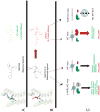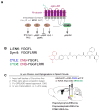New Technologies for Elucidating Opioid Receptor Function
- PMID: 26833118
- PMCID: PMC4811714
- DOI: 10.1016/j.tips.2016.01.001
New Technologies for Elucidating Opioid Receptor Function
Abstract
Recent advances in technology, including high resolution crystal structures of opioid receptors, novel chemical tools, and new genetic approaches have provided an unparalleled palette of tools for deconstructing opioid receptor actions in vitro and in vivo. Here we provide a brief description of our understanding of opioid receptor function from both molecular and atomic perspectives, as well as their role in neural circuits in vivo. We then show how insights into the molecular details of opioid actions can facilitate the creation of functionally selective (biased) and photoswitchable opioid ligands. Finally, we describe how newly engineered opioid receptor-based chemogenetic and optogenetic tools, and new mouse lines, are expanding and transforming our understanding of opioid function and, perhaps, paving the way for new therapeutics.
Keywords: DREADDs; biased signaling; chemogenetics; functional selectivity; mouse models; optogenetics.
Copyright © 2016 Elsevier Ltd. All rights reserved.
Figures



Similar articles
-
Opioid receptors: Structural and mechanistic insights into pharmacology and signaling.Eur J Pharmacol. 2015 Sep 15;763(Pt B):206-13. doi: 10.1016/j.ejphar.2015.05.012. Epub 2015 May 14. Eur J Pharmacol. 2015. PMID: 25981301 Free PMC article. Review.
-
Structure and regulation of opioid receptors.Biopolymers. 2000;55(4):334-46. doi: 10.1002/1097-0282(2000)55:4<334::AID-BIP1006>3.0.CO;2-S. Biopolymers. 2000. PMID: 11169924 Review.
-
Advances in optogenetic and chemogenetic methods to study brain circuits in non-human primates.J Neural Transm (Vienna). 2018 Mar;125(3):547-563. doi: 10.1007/s00702-017-1697-8. Epub 2017 Feb 25. J Neural Transm (Vienna). 2018. PMID: 28238201 Free PMC article. Review.
-
Homology modeling of opioid receptor-ligand complexes using experimental constraints.AAPS J. 2005 Oct 5;7(2):E434-48. doi: 10.1208/aapsj070243. AAPS J. 2005. PMID: 16353922 Free PMC article. Review.
-
[Functional selectivity of opioid receptors ligands].Med Sci (Paris). 2010 Aug-Sep;26(8-9):734-9. doi: 10.1051/medsci/2010268-9734. Med Sci (Paris). 2010. PMID: 20819711 Review. French.
Cited by
-
A Review of the Therapeutic Potential of Recently Developed G Protein-Biased Kappa Agonists.Front Pharmacol. 2019 Apr 17;10:407. doi: 10.3389/fphar.2019.00407. eCollection 2019. Front Pharmacol. 2019. PMID: 31057409 Free PMC article. Review.
-
Computational insights into the G-protein-biased activation and inactivation mechanisms of the μ opioid receptor.Acta Pharmacol Sin. 2018 Jan;39(1):154-164. doi: 10.1038/aps.2017.158. Epub 2017 Nov 30. Acta Pharmacol Sin. 2018. PMID: 29188799 Free PMC article.
-
Key differences in regulation of opioid receptors localized to presynaptic terminals compared to somas: Relevance for novel therapeutics.Neuropharmacology. 2023 Mar 15;226:109408. doi: 10.1016/j.neuropharm.2022.109408. Epub 2022 Dec 28. Neuropharmacology. 2023. PMID: 36584882 Free PMC article. Review.
-
MP1104, a mixed kappa-delta opioid receptor agonist has anti-cocaine properties with reduced side-effects in rats.Neuropharmacology. 2019 May 15;150:217-228. doi: 10.1016/j.neuropharm.2019.02.010. Epub 2019 Feb 13. Neuropharmacology. 2019. PMID: 30768946 Free PMC article.
-
Mu-Opioid receptor biased ligands: A safer and painless discovery of analgesics?Drug Discov Today. 2017 Nov;22(11):1719-1729. doi: 10.1016/j.drudis.2017.07.002. Epub 2017 Jul 22. Drug Discov Today. 2017. PMID: 28743488 Free PMC article. Review.
References
-
- Waldhoer M, et al. Opioid receptors. Annu Rev Biochem. 2004;73:953–990. - PubMed
-
- Martin WR, et al. The effects of morphine and morphine-like drugs in the non-dependent and morphine-dependent chronic spinal dog. Journal of Pharmacology and Experimental Therapeutics. 1976;197:517–532. - PubMed
-
- Robson LE, Kosterlitz HW. Specific protection of the binding sites of D-Ala2-D-Leu5-enkephalin (delta-receptors) and dihydromorphine (mu-receptors) Proc R Soc Lond B Biol Sci. 1979;205:425–432. - PubMed
Publication types
MeSH terms
Substances
Grants and funding
LinkOut - more resources
Full Text Sources
Other Literature Sources

